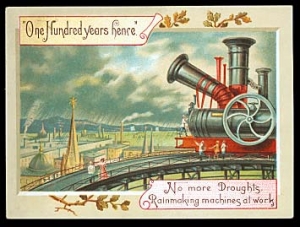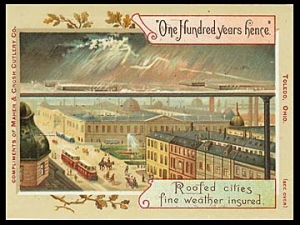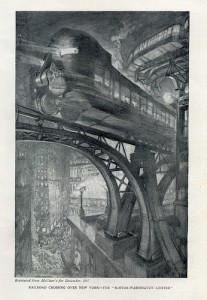
- “One Hundred Years Hence” | No more Droughts. Rainmaking machines at work | Trading Cards “Compliments of Maher & Grosh Cutlery Co.” Toledo, Ohio

- “One Hundred Years Hence” | Roofed cities fine weather insured. | Trading Cards “Compliments of Maher & Grosh Cutlery Co.” Toledo, Ohio
The endings of things also cause us to anticipate subsequent beginnings. As the country anticipated the dawning of the 20th century, people began to speculate what changes and developments the new century would bring. One of the most popular novels at the time was a piece of speculative and science fiction first published in 1888 by Edward Bellamy called Looking Backward. Bellamy’s story is about a young Boston man, Julian West, who awakens after more than a century of a trance-induced sleep. In America of the year 2000 West finds full employment, material abundance, and social harmony. Filled with futuristic inventions including credit cards, shopping malls, and electronic broadcasting, Bellamy’s best-selling novel galvanized America’s imagination. Similarly various European and American printing companies produced trade cards with illustrations speculating what life would be like in one hundred years time. This series of cards was called One Hundred Years Hence and the original source may have been the Kunstdruck-Friedberg printing plant in Berlin, Germany. While the images are identical in the American and European versions, their borders and backgrounds are different.[ii] The illustrator of these cards hypothesized that cities would be protected under cover from the elements ensuring that fine weather would be a daily occurrence; that families and individuals would own and operate their own flying machines similar to the way many of us own and operate our own automobiles; that moving sidewalks would make shopping and socializing easy; and that portable rainmaking machines would prevent future worries about drought. Hand in hand with these cards illustrating hypothetical future advances, was a concurrent literature sparked by the futurist imaginings of such literary greats as Jules Verne (1828-1905), who’s publications from the mid-1860s through his death made him one of the fathers of science fiction. A generation or two younger, H. G. Wells (1866-1946) and Hugo Gernsback (1884-1967) respectively are also sometimes deemed fathers of science fiction: the first for his late 19th century stories, and the second for his creation of a magazine dedicated to the genre, Amazing Stories. To have science fiction, it is said that you must believe that the things you imagine as possibly happening can indeed actually happen. What better time for science fiction and the imaginings of a mechanically resolved future, than at the end of the 19th century when mechanical and technological advancements have changed the way people lived and the way the world looked. Even beyond the turn-of-the-century there was continued discussion and imaginings of what our future cities would look like. For example in 1910 there was considerable interest in the United States about creating an elevated rail line running from Washington, D.C. to Boston based on the gyroscope-balanced monorail trains modeled first in 1903 by the Irish-Australian inventor, Louis Brennan (1852-1932). Brennan said that his train cars might achieve as much as 200 mph.[iii] As a comparison, Amtrak’s Acela tilting trains can reach 150 mph. In André Castaigne’s illustration for the McClure’s magazine article on the proposal, notice the Flatiron Building’s narrow front edge in the middle ground left side of the picture, and how this future rail line is elevated above and races through the future busy, even congested city. Remember, the future is only a tomorrow away. May all our futures be filled with wonders and success. December 29, 2011
no longer have housekeeping chores.







